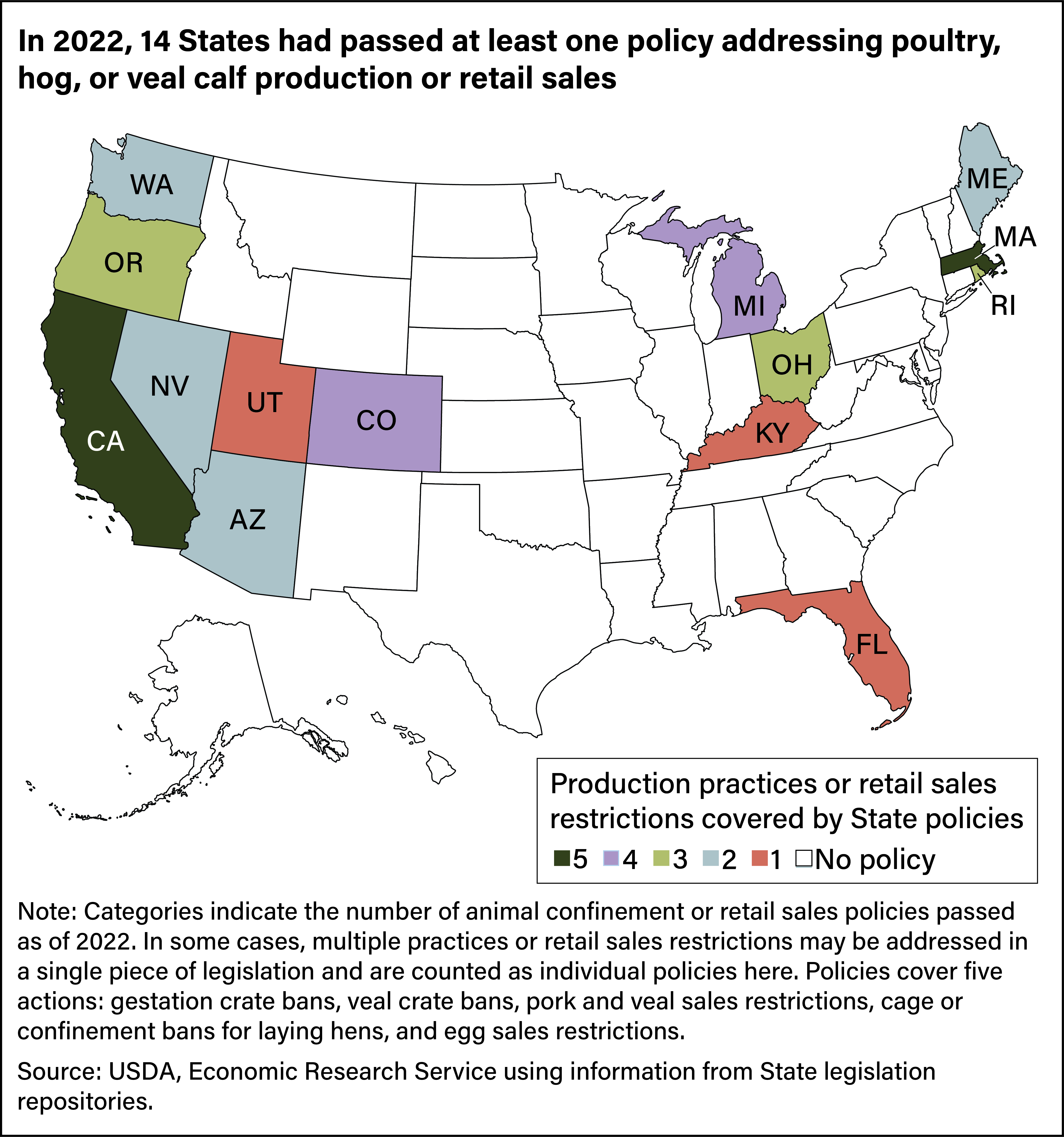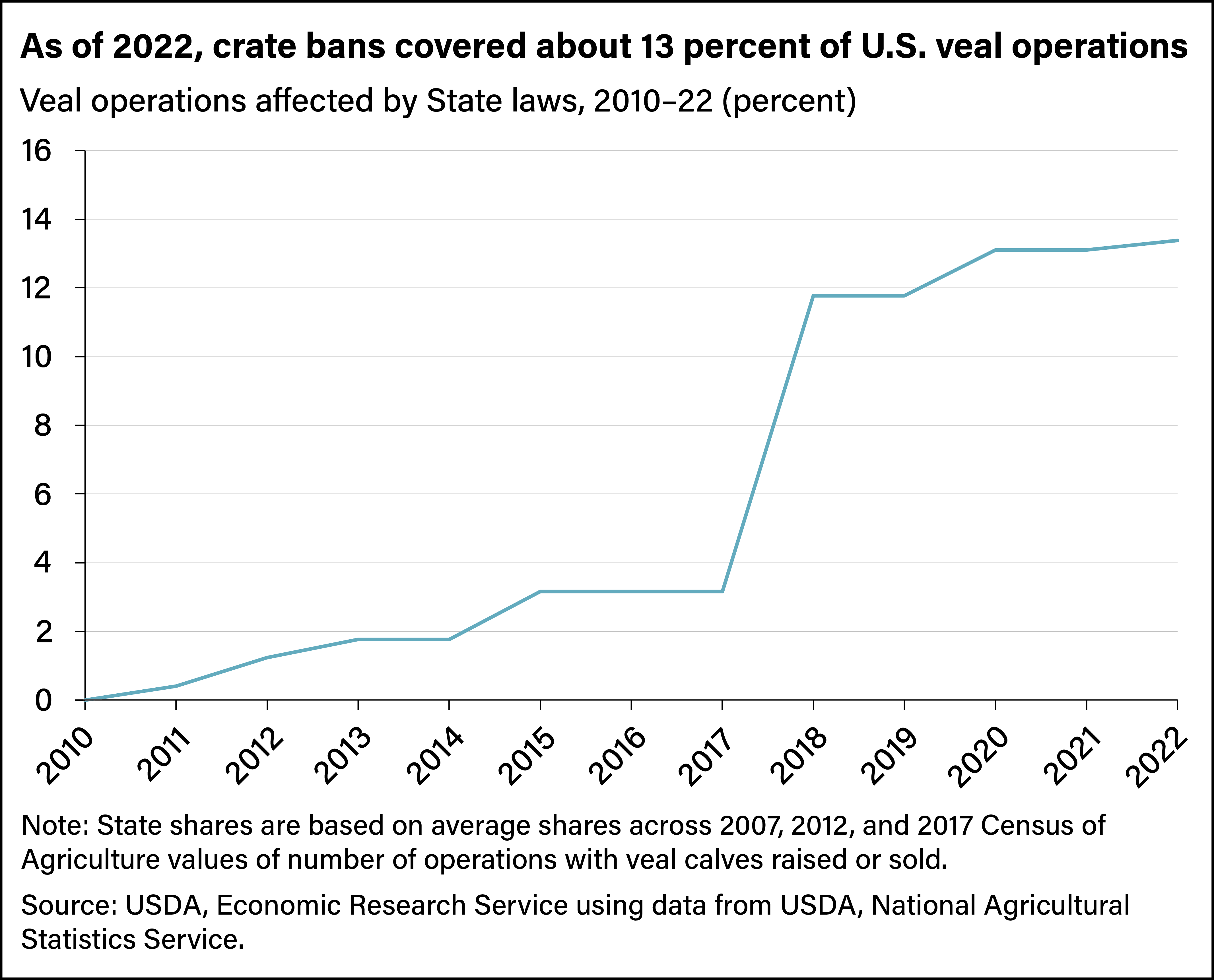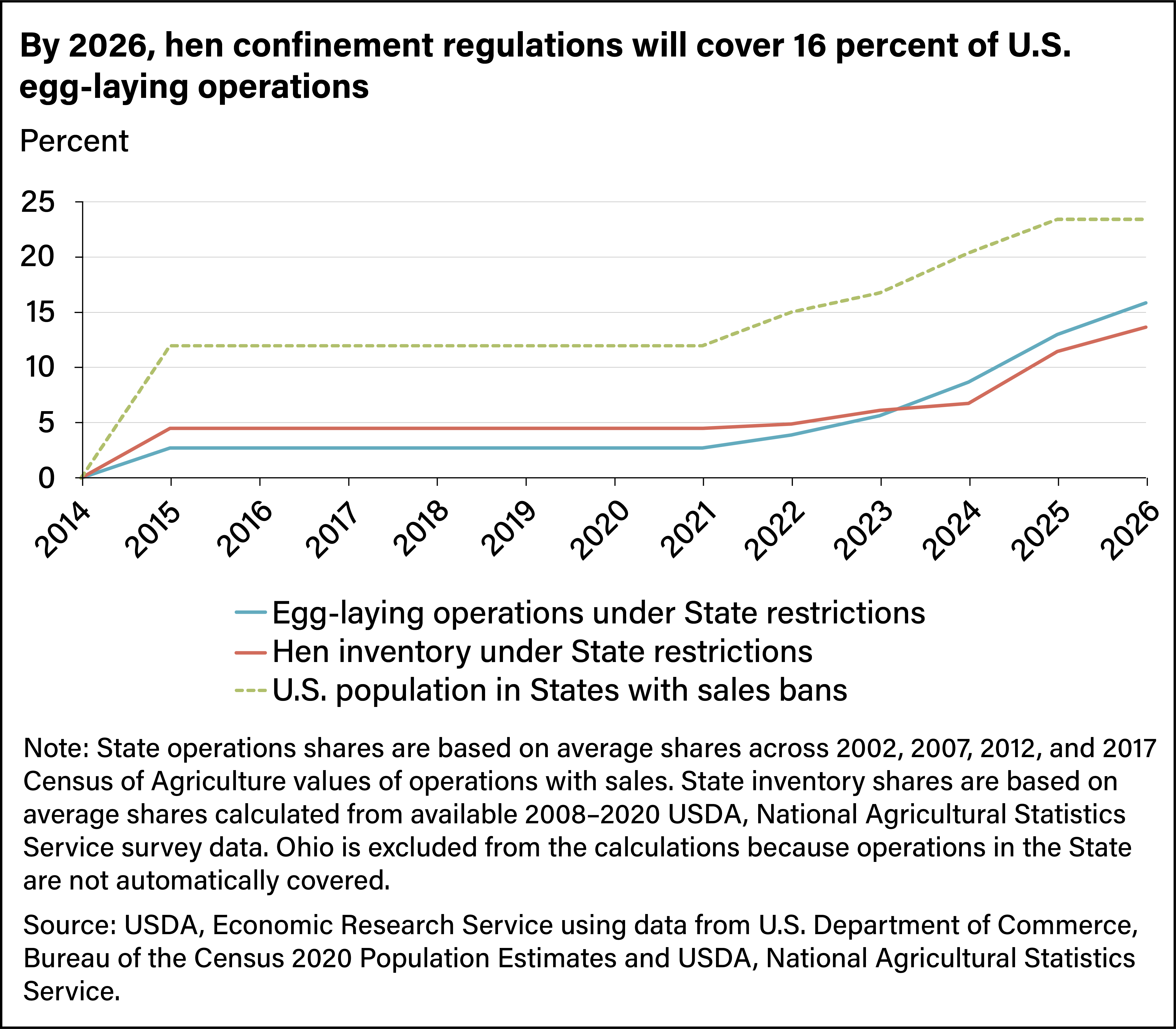
Farm Animal Welfare Policies Cover Breeding Sows, Veal Calves, or Laying Hens in 14 U.S. States
- by Danielle J. Ufer
- 4/24/2023
Highlights
- Farm animal welfare policies covering production practices before slaughter are in place in 14 States, with policies largely focused on confinement practices. Requirements for alternative methods of animal production are expected to come at a cost.
- In-State animal operations targeted by these bans account for a relatively small proportion of total U.S. production.
- Some laws also restrict the sale of animal products originating from any noncompliant operation, including from States where such bans are not in place. This can create a bleed-over effect in which out-of-State producers must adopt similar animal welfare practices to keep their market access.
In the United States, animal welfare standards are among the many considerations facing producers. Until recently, relatively few Federal policies addressed standards of treatment for farm animals, allowing each industry to largely define those standards. Since 2002, 14 U.S States have passed policies addressing practices that can affect farm animal welfare, with the most common policies aimed at the use of animal confinement in pork, veal, and egg production. Moreover, some States ban sales of animal products imported from operations in other States that do not follow the animal welfare requirements. But even with a growing geographic reach, these policies cover a relatively small proportion of U.S. animal production.
Hog Gestation Crate Bans Will Cover 10 States and 6 Percent of U.S. Hog Herd by 2026
Over the past two decades, the hog industry has been at the center of much of the State legislation addressing farm animal welfare. Ten States (Arizona, California, Colorado, Florida, Maine, Massachusetts, Michigan, Ohio, Oregon, and Rhode Island) have passed laws restricting the use of gestation crates for hogs, in many cases allowing confinement only in limited circumstances. These crates typically are metal pens about 7 feet long that house individual breeding sows for the entire gestation. Other than Michigan and Ohio, most States banning gestation crates each produce less than 1 percent of total U.S. pork output. By 2026, when all currently passed policies will have been fully implemented, less than 8 percent of the U.S. breeding hog inventory (at currently reported levels) will be covered by a gestation crate ban. Even so, the bans will affect a proportionally smaller share of pork producers because hog operations in these 10 States tend to be smaller than those in States with larger industries. While the gestation crate bans will cover about 6 percent of the total U.S. hog inventory by 2026, more than 17 percent of U.S. pork producer operations will be subject to a gestation crate ban if the distribution of operations remains at current levels.
Gestation crates have been shown to increase efficiency compared with putting sows in group settings. The crates allow producers to control how much each sow eats, to alleviate problems if sows become aggressive, and to monitor overall health. Converting operations to other containment methods could pose an additional cost to producers. For an operation that raises hogs from birth to slaughter weight (farrow-to-finish operations), converting away from gestation stalls would increase the per-pound cost of producing finished hogs by 8.7 percent, according to a 2011 estimate by Oklahoma State University researchers. Although these costs can be substantial for producers, the small size of industries in States that have banned crates and the retail availability of pork produced in States without the same restrictions mean that gestation crate bans alone may not have a discernible effect on retail prices.
However, when the policies extend beyond the hog barn and reach the grocery aisles, those costs can affect consumer prices. California and Massachusetts passed bans on retail sales of all pork from hogs that were kept in gestation crates, as well as their offspring, even if they were raised in other States. In California, it is estimated pork prices could increase 7.7 percent under the ban, reducing demand by 6.3 percent and resulting in an annual loss of economic benefits to consumers worth $320 million. However, enforcement of the California ban, stemming from voter approval of a ballot issue known as Proposition 12, as well as a similar ban in Massachusetts, has been delayed until the U.S. Supreme Court rules on a challenge to Proposition 12.
Nine States Prohibit Veal Crates, Affecting 13 Percent of Veal Operations as of 2022
Several State policies outlawing the use of gestation crates or confinement in pork production also prohibit the use of crates in the veal industry. Of the 10 States with gestation crate laws, 8 States (not including Florida and Oregon) also prohibit veal crates. In addition, Kentucky enacted a ban on veal crates in 2014. Bans on crating veal calves have had minimal effect on that industry. Crates were historically used in veal production to limit calf movement and interaction with other calves with the goals of improved animal health and meat quality. However, the American Veal Association reports producers already have moved away from veal crates as the industry standard and instead house veal calves in small groups. Moreover, the U.S. veal industry has seen significant decline since its peak in 1944, when more than 1.7 billion pounds of veal were produced. By 2020, U.S. veal output had dropped to 69 million pounds. Even with a relatively small national industry, State policies banning veal crates affect production along the same lines as hog gestation crate bans. Before policies in Kentucky and Ohio went into full effect in 2018, veal crate ban policies covered slightly more than 3 percent of veal operations nationally. Kentucky’s ban alone raised this number by 6 percent and, with all current bans fully implemented in 2022, about 13 percent of veal operations in the United States are covered by a crate ban.
Welfare Laws for Egg-Laying Hens to Cover 16 Percent of All U.S. Operations By 2026
Since 2008, 10 States (California, Colorado, Massachusetts, Michigan, Nevada, Ohio, Oregon, Rhode Island, Utah, and Washington) have instituted policies addressing the caging or confinement of poultry, primarily affecting the egg industry. The policies in these 10 States typically require either a minimum amount of space per bird (in some cases a 73-percent increase in space over the industry standard) or have outlawed the use of battery cages, which confine large groups of laying hens in a small space and are stacked multiple layers deep within a barn. Though confinement and cage ban policies covered less than 5 percent of U.S. layers and egg operations before 2022, upon full implementation in 2026 they will cover at least 16 percent of operations, accounting for nearly 14 percent of layers (at currently reported levels, excluding Ohio where regulations do not automatically cover all in-State producers).
Researchers at the University of California, Davis, estimated that in-State producers faced as much as a 20-percent increase in production costs from these laws. With the stated goal of protecting in-State egg producers, California, Colorado, Massachusetts, Michigan, Nevada, Oregon, and Washington also have imposed bans on retail sales of products from any operations that do not comply with their individual State’s production regulations. Under current population levels, by 2026 more than 23 percent of the U.S. population would reside in States with retail sales restrictions. That will put pressure on in-State industries to meet demand and spread the effects of these State policies to States that do not have their own restrictions. The retail sales policies have increased egg prices both inside and outside of the States implementing them. Researchers estimated egg prices in California increased by 33 percent to 70 percent from January 2014 (before California’s retail sales law went into effect) to July 2015. From 2016 to 2017, wholesale egg prices outside of California were estimated to have increased 4 percent to 6 percent, though the estimated price effects of California’s legislation around this time could also have been influenced by the 2014–15 U.S. outbreak of highly pathogenic avian influenza.
Though State policies on the treatment and welfare of farm animals have limited coverage and have faced legal challenges, they are not operating in a vacuum. In addition to the direct regulatory effects on industry, several national trends have emerged with similar objectives. U.S. cage-free egg production has steadily increased over the past 5 years, rising from an estimated cage-free hen inventory of 12.9 percent in 2017 to 24 percent at the end of 2021. Additionally, USDA Certified Organic egg production, which prohibits cage systems and confinement that restricts animal movement, has grown to represent more than 4.5 percent of the national layer inventory in 2019. Members of the supply chain have increased their attention to animal treatment, with several national grocery chains, wholesalers, and food service providers making commitments to phase out egg and pork products originating in battery cage or gestation crate systems. Together with increased implementation of State policies addressing these practices, current trends in the pork and egg industries reflect an ongoing shift in U.S. standards of animal production.
This article is drawn from:
- Ufer, D.J. (2022). State Policies for Farm Animal Welfare in Production Practices of U.S. Livestock and Poultry Industries: An Overview. U.S. Department of Agriculture, Economic Research Service. EIB-245.
You may also like:
- Knight, R., Davis, C.G., Hahn, W., Cessna, J., Terán, A., Haley, M., Valcu-Lisman, A., Grossen, G., Taylor, H., Cornelius, M. & Ufer, D.J. (2022). Livestock, Dairy, and Poultry Outlook: February 2022. U.S. Department of Agriculture, Economic Research Service. LDP-M-332.





